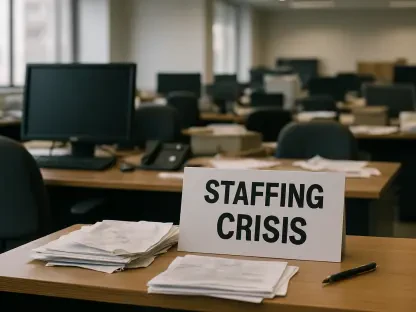Imagine a scenario where law enforcement officers arrive unexpectedly at a workplace, seeking to arrest an employee or investigate a matter tied to immigration policies, creating tension and potential legal risks. Such situations can disrupt operations and pose challenges if not handled with care, so employers must be prepared to navigate these encounters effectively to protect their workforce and maintain compliance with legal standards. At a recent labor and employment law conference hosted by the American Bar Association, experts emphasized the importance of having a proactive response plan in place. With increasing focus on workplace raids as part of broader policy goals, businesses face heightened scrutiny. A well-structured strategy can mitigate risks and ensure that interactions with authorities are managed professionally. This discussion explores six essential strategies to prepare for and handle law enforcement visits at work, offering actionable insights for employers across industries.
1. Designating and Training a Primary Contact
Selecting the right individual to serve as the first point of contact during a law enforcement visit is a critical step for any organization. This person, often someone at the front desk or in a reception role, should be thoroughly trained on how to respond when officers arrive. Training should cover the appropriate language to use, maintaining a calm demeanor, and knowing exactly who to notify within the company hierarchy. Experts suggest adopting a cautious approach, similar to limiting access unless absolutely necessary, to control the scope of interaction. By restricting entry to certain areas, the organization can maintain a degree of authority over the situation. This initial interaction sets the tone for the entire encounter, making preparation vital. Without proper guidance, an untrained employee might inadvertently grant access or provide information that could complicate matters, potentially exposing the company to legal vulnerabilities.
Beyond identifying and training the primary contact, it’s equally important to ensure they understand the boundaries of their role. This individual should not engage in detailed discussions or make decisions on behalf of the company. Instead, their focus should be on following a predefined protocol, which includes alerting the designated intermediary or legal counsel as quickly as possible. Training programs should emphasize the importance of politeness while firmly adhering to company policies regarding access and information sharing. Regular drills or refreshers can help reinforce these skills, ensuring the contact person remains confident under pressure. Additionally, clear documentation of the protocol should be accessible to avoid confusion during high-stress moments. This preparation not only protects the organization but also empowers employees to handle unexpected situations without overstepping their authority or risking escalation.
2. Preparing an Intermediary for Communication
Once the primary contact alerts the appropriate personnel, an on-site intermediary, such as a plant manager or supervisor, must step in to manage the situation. This individual should be well-versed in a communication plan designed to de-escalate tensions while facilitating contact with legal counsel. Their role is to act as a buffer, ensuring that interactions with law enforcement remain professional and aligned with company policies. Training for this position should include strategies for maintaining composure and avoiding confrontational behavior, even in challenging circumstances. The intermediary’s primary goal is to buy time for legal experts to provide guidance, preventing any premature decisions that could have lasting repercussions for the organization or its employees.
In addition to de-escalation tactics, the intermediary must be familiar with the legal limits of law enforcement’s authority during a workplace visit. This includes understanding when and how to request documentation, such as a warrant, before allowing access to restricted areas. The intermediary should also document the interaction meticulously, noting the time, individuals involved, and any statements made by officers. This record can prove invaluable if disputes arise later. Collaboration with HR and legal teams prior to any incident ensures that the intermediary is not operating in isolation but as part of a broader strategy. By establishing clear lines of communication and authority, companies can avoid missteps during these encounters, protecting both their interests and the rights of their workforce in a balanced manner.
3. Mapping Public and Private Spaces
Creating a detailed map that delineates public and private areas within a workplace is a strategic move for employers. This document, developed in consultation with legal counsel, clarifies which spaces law enforcement can access without specific authorization. For instance, areas behind secured entry points or requiring employee badges might be designated as private, while a lobby could be considered public. However, the effectiveness of such designations hinges on consistent enforcement. If employees occasionally leave secured doors open or fail to adhere to access protocols, the argument for privacy in those spaces weakens significantly. Regularly reviewing and updating this map ensures it reflects current workplace layouts and security measures.
Beyond mapping, employees at all levels must be trained to respect and maintain these boundaries. This involves educating staff on the importance of keeping private areas secure and reporting any lapses in protocol, such as unauthorized access or propped-open doors. Legal counsel can assist in navigating complex scenarios, especially in industries like hospitality where public and private spaces often blur. For example, in a restaurant, determining whether a kitchen is private can be contentious and may require specific legal arguments. By proactively addressing these ambiguities, companies can strengthen their position during law enforcement visits, ensuring that officers respect designated boundaries while minimizing the risk of operational disruptions or legal challenges.
4. Equipping HR with a Response Strategy
Human Resources departments play a pivotal role in managing law enforcement interactions, particularly when inquiries relate to employee records or immigration status. A tailored response plan for HR should outline who will communicate with authorities and how to address their requests. This plan must prioritize compliance with legal obligations while safeguarding sensitive information. Conducting tabletop exercises with senior leadership can help refine this strategy, preparing HR personnel for real-world scenarios. Such simulations allow teams to identify potential gaps in their approach, ensuring a cohesive response when faced with actual visits from agencies like ICE.
Additionally, HR should collaborate closely with legal counsel to ensure that responses align with both company policy and federal or state regulations. This partnership helps in crafting statements or actions that avoid unnecessary disclosures while maintaining transparency where required. Training for HR staff should focus on recognizing the scope of law enforcement’s requests and knowing when to defer to legal experts. Documentation of all interactions is also crucial, as it provides a clear record for future reference or legal proceedings. By embedding these practices into daily operations, HR can act as a steady hand during uncertain situations, balancing employee rights with organizational responsibilities effectively.
5. Conducting Proactive Internal Audits
Proactive internal audits are a cornerstone of preparedness for law enforcement interactions, especially concerning documentation like Form I-9s. These forms, which verify an employee’s eligibility to work in the United States, can become a focal point during investigations. Employers should regularly review these documents to ensure they are completed accurately and that supporting identification appears authentic. Conducting such audits under the guidance of legal counsel helps maintain privilege, protecting the process from being used against the organization in legal disputes. This systematic approach reduces vulnerabilities before they can be exploited.
Moreover, audits should extend beyond paperwork to include a broader review of compliance practices. This might involve assessing training programs, security protocols, and employee awareness of response plans. Identifying discrepancies early allows for corrective action without the pressure of an immediate law enforcement visit. Legal counsel can provide insights into evolving regulations, ensuring that audits remain relevant over time. By fostering a culture of accountability and diligence, organizations can demonstrate good faith efforts to comply with laws, potentially mitigating penalties or scrutiny during official reviews.
6. Leveraging Security and Video Systems
The role of video recordings in documenting law enforcement interactions at the workplace cannot be understated. Security cameras, often positioned at entry points and equipped with timestamps, provide an objective record of events. This footage can be critical in verifying whether actions taken by officers align with the scope of their authority, such as adhering to a warrant’s limitations. However, employers must ensure that these systems are operational and compliant with privacy laws to avoid unintended legal issues. Strategically using such technology can bolster a company’s position in post-incident reviews or court proceedings.
Employees, too, must exercise caution when recording interactions on personal devices, as this can sometimes lead to accusations of obstruction. Training should emphasize safe and legal ways to document events without interfering with law enforcement activities, such as avoiding blocking pathways. Companies should establish clear policies on the use of recordings, balancing transparency with risk management. Consulting with legal experts to understand the implications of video evidence in specific jurisdictions is advisable. This dual approach—utilizing security systems while guiding employee behavior—ensures that documentation serves as a protective tool rather than a liability.
Final Reflections on Preparedness
Looking back, the strategies discussed at the labor and employment law conference provided a robust framework for handling law enforcement encounters at work. Employers who took heed of expert advice likely found themselves better equipped to manage unexpected visits with confidence and legal clarity. Moving forward, the focus should shift to continuous improvement of response plans, incorporating lessons learned from past interactions. Regular updates to training programs and audits, alongside consultations with legal counsel, can keep organizations ahead of evolving challenges. Exploring technological advancements, such as enhanced security systems, also offers new avenues for protection. By embedding these practices into their operations, businesses not only safeguard their interests but also foster a safer, more compliant workplace environment for all stakeholders involved.









